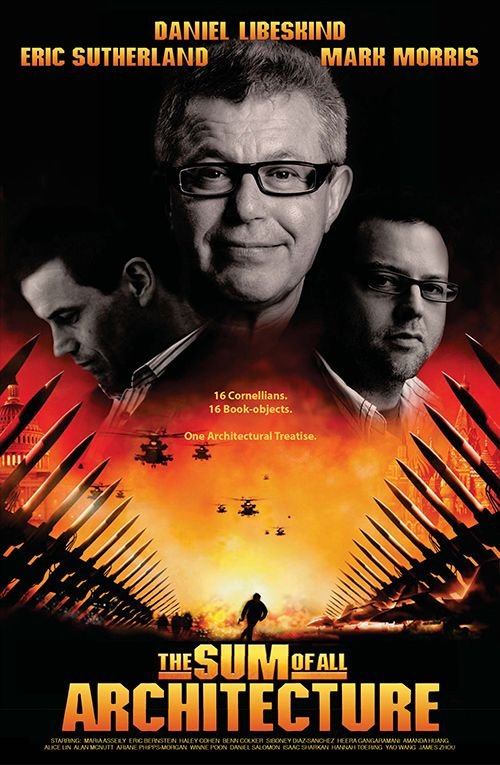
The Sum of All Architecture
In 2009, I participated in an architecture studio lead by starchitect Daniel Libeskind. The concept of the studio was daunting for a third-year architecture student like myself: to sum up all architecture in the creation of a book-object, and inspire my entire future career in the process. Each member of the studio was given a book created by Daniel Libeskind that was meant to be his own summation of architecture, and thus we were supposed to return the favor by each creating our own book. For a school publication I wrote the following synopsis of our studio and created a tongue-in-cheek poster to go with it:

The Sum of All Fears, an action film starring Ben Affleck and Morgan Freeman, hit theaters in 2002 and received mixed reviews. The Sum of All Architecture, a studio starring sixteen Cornellians, produced by Daniel Libeskind, and directed by Mark Morris and Eric Sutherland, will premiere in the Hartell Gallery in early December. The studio’s given name is Architecture in a Box: the Book-object, but I prefer the aforementioned title, as its epic tone gives us an Indiana Jones-like sense of adventure, which seems appropriate given our current quest. However it is important to stress what Mark Morris made a note of emphasizing when he said those grand and terrifying words, “the sum of all architecture, to you…to you” (twice for extra emphasis). The act of summing up all architecture is therefore, first and foremost, about defining our own inevitable boundaries that come with architectural adolescence. But our youth is to be revered, as it allows us to evaluate ourselves before our freedom is overrun by real life responsibility.
Villa Savoye by Le Corbusier
Almost immediately after being assigned the task of creating the "sum of all architecture," I knew my book-object would be an exploration of Villa Savoye by Le Corbusier. For the entire duration of my studies at Cornell's architecture program, my professors had been pushing the importance of this building, and I felt it was time to express my opinion about it. The building is considered to be a high point in Le Corbusier's career because it implements his five points of architecture: pilotis (supports, like columns, which elevate the building above the earth), roof garden, open floor plan, long horizontal windows, and free facade.
My commentaries about Villa Savoye were less an attack on his style of modern architecture, and more a reaction to his close-minded attitude. I do in fact greatly respect the innovations he brought to architecture (although I would never want to live in one of his homes myself). Most of all my commentaries were an expression of the fact that I had reached a place in my architectural education where I felt, finally, I could have an opinion. Whether I actually support the ideas that I spray-painted onto these photos is besides the point, the narrative you'll find below is simply a mechanism used to display my coming-of-age as a designer. I'll never forget Daniel Libeskind's response to my final installation: he called it "subversive," which I took as a huge compliment.

54 Murals (Free of Charge) on the Savoye House at Poissy
My book-object was not just a commentary on the Villa Savoye, it was an extensive narrative inspired by historical truth. Sometime in 1938, Le Corbusier entered a building called E.1027 designed by architect Eileen Gray and proceeded to paint what he called, "eight mural paintings (free of charge) in the Badovici and Helen Grey house at Cap Martin." He did this without permission, as a statement of power. After a long history of disrespecting women, this was yet another action that proved his bigotry and pretentiousness. Instead of expressing my reactions to this episode through my own voice, I created a fictional narrative in which Eileen Gray gets revenge on Le Corbusier by breaking into Villa Savoye and painting 54 murals (free of charge) onto its walls. The murals took the form of graffiti spray-painted onto a collection of photos of Villa Savoye, which I displayed at Hartell Gallery in Ithaca, New York in 2009.

18" x 18" each, spray paint on paper and cardboard, 2009

Below you'll find a selection of the "murals" along with the stencils used to create each one. The subject matter of each image was largely in response to direct quotations from Le Corbusier's manifesto called Toward a New Architecture. I took note of his pompous statements of authority and attempted to turn them back around on him on the walls of his own building.






Let me know what you think of this series in the comments below.

